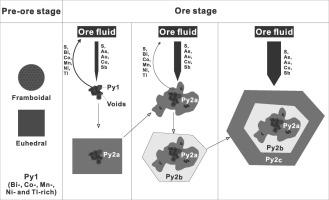当前位置:
X-MOL 学术
›
Chem. Geol.
›
论文详情
Our official English website, www.x-mol.net, welcomes your
feedback! (Note: you will need to create a separate account there.)
Ore-forming fluid source of the orogenic gold deposit: Implications from a combined pyrite texture and geochemistry study
Chemical Geology ( IF 3.6 ) Pub Date : 2020-10-01 , DOI: 10.1016/j.chemgeo.2020.119781 Rucao Li , Huayong Chen , Ross R. Large , Liandang Zhao , Yunhua Liu , Jiangang Jiao , Xiao-Ping Xia , Qing Yang
Chemical Geology ( IF 3.6 ) Pub Date : 2020-10-01 , DOI: 10.1016/j.chemgeo.2020.119781 Rucao Li , Huayong Chen , Ross R. Large , Liandang Zhao , Yunhua Liu , Jiangang Jiao , Xiao-Ping Xia , Qing Yang

|
Abstract Interpretation of bulk sulfur isotope data of the orogenic gold deposit is frequently hampered by complex zoning in pyrite, which calls for in-situ determination of sulfur isotope composition of sulfide minerals. The Qiuling gold deposit, located in Qinling orogen, is representative of orogenic type and selected here to further constrain the source of sulfur (and Au) and test the current popular ore genesis models for deposits of this type. Detailed backscattered electron imaging (BSE) study is applied to characterize intragrain texture, and subsequently in-situ sulfur isotope and trace element determination using secondary ion mass spectrometry (SIMS) and laser ablation-inductively coupled plasma-mass spectrometry (LA-ICP-MS) are used to reveal sulfur and metal source and evolution of the ore-forming fluid. Two generations of pyrite, i.e., pre-ore stage (Py1) and ore stage pyrite (Py2), were investigated in this study. In most cases, Py1 occurs as pyrite framboids, while Py2 as euhedral grains, in which Py2a as anhedral core, Py2b and Py2c as euhedral inner and outer rim, respectively. The δ34S values of both Py1 and Py2 have unusual wide ranges, i.e., a δ34S variation from −31.1 to +106.7‰ for Py1 (average +0.8‰) and from −2.7 to +24.1‰ for Py2 (average +13.2). The distribution pattern of δ34S values in Py1 is accommodated with Rayleigh fractionation in sulfate-restricted pore water. Modeling results show that neither temperature nor oxygen fugacity change could result the variations in δ34S values of Py2, and contribution of both preexisting pyrite and a pulse of ore-forming fluid with δ34S about +14.2‰ may be responsible for the observed variation in Py2. Such fluid may have been sourced from metamorphism of old strata such as the Neoproterozoic basement. Furthermore, Py2a shows an intimate relationship with Py1 in its δ34S values, indicating Py1 may have acted as part of sulfur source in the formation of Py2a. Py1 is rich in a suit of element such as Bi, Co, Mn, Ni, Tl and has the lowest As and Au. Py2a is similar with Py1 but with elevated As and Au. Py2b contains more abundant As and Au compared to Py2a. Py2c is rich in As and especially Au, but depleted in other elements compared to Py2a. The distribution pattern, coupled with sulfur isotope composition, indicates that Py2a was likely formed with a contribution of trace elements and sulfur from Py1 at the start of hydrothermal process. Py2b was formed with elevated proportion of contribution from the ore-forming hydrothermal fluid, while Py2c was formed solely by the ore-forming fluid without a contribution from previous pyrite. Consequently, the ore-forming fluid in the Qiuling gold deposit was rich in As, Au, Cu and Sb while depleted in other metals such as Bi, Co, Mn, Ni and Tl, indicating that the pre-ore framboid pyrite may have not contributed any Au and As during mineralization. This study highlights the importance of detailed texture characterization coupled with relatively large data set of in-situ sulfur isotope and trace elements for orogenic gold deposit research, and further proves that metamorphic fluids may have significant contribution for Au mineralization in orogenic gold deposits.
中文翻译:

造山型金矿床的成矿流体来源:结合黄铁矿结构和地球化学研究的意义
摘要 黄铁矿中复杂的分带经常阻碍对造山带金矿床的大量硫同位素数据的解释,这需要原位测定硫化物矿物的硫同位素组成。位于秦岭造山带的秋岭金矿床是造山类型的代表,选择这里是为了进一步约束硫(和金)的来源,并测试当前流行的该类型矿床的成矿模型。详细的背散射电子成像 (BSE) 研究用于表征晶粒内结构,随后使用二次离子质谱法 (SIMS) 和激光烧蚀电感耦合等离子体质谱法 (LA-ICP-MS) 进行原位硫同位素和痕量元素测定) 用于揭示硫和金属的来源和成矿流体的演化。两代黄铁矿,即 本研究调查了矿前阶段 (Py1) 和矿阶段黄铁矿 (Py2)。在大多数情况下,Py1 以黄铁矿 framboids 的形式出现,而 Py2 为自形晶粒,其中 Py2a 作为自形核,Py2b 和 Py2c 分别作为自形内缘和外缘。Py1 和 Py2 的 δ34S 值都有不同寻常的宽范围,即 Py1 的 δ34S 变化从 -31.1 到 +106.7‰(平均 +0.8‰)和 Py2 从 -2.7 到 +24.1‰(平均 +13.2)。Py1 中 δ34S 值的分布模式与硫酸盐限制孔隙水中的瑞利分馏相适应。模拟结果表明,温度和氧逸度的变化都不会导致 Py2 的 δ34S 值的变化,并且预先存在的黄铁矿和 δ34S 约 +14.2‰ 的成矿流体脉冲的贡献可能是 Py2 观测到的变化的原因。这种流体可能来源于新元古代基底等旧地层的变质作用。此外,Py2a 的 δ34S 值显示出与 Py1 的密切关系,表明 Py1 可能在 Py2a 的形成过程中充当了硫源的一部分。Py1富含Bi、Co、Mn、Ni、Tl等元素,As和Au含量最低。Py2a 与 Py1 相似,但 As 和 Au 升高。与 Py2a 相比,Py2b 包含更丰富的 As 和 Au。Py2c 富含 As,尤其是 Au,但与 Py2a 相比,其他元素较少。分布模式,加上硫同位素组成,表明 Py2a 很可能是在水热过程开始时由 Py1 中的微量元素和硫的贡献形成的。Py2b 形成时来自成矿热液的贡献比例较高,而 Py2c 仅由成矿流体形成,没有先前黄铁矿的贡献。因此,秋岭金矿床成矿流体富含As、Au、Cu、Sb,而贫Bi、Co、Mn、Ni、Tl等其他金属,说明成矿前的黄铁矿可能没有在矿化过程中贡献了任何金和砷。本研究强调了详细的质地表征以及相对较大的原位硫同位素和微量元素数据集对造山金矿床研究的重要性,并进一步证明变质流体可能对造山金矿床的金矿化有重大贡献。Cu 和 Sb 贫化了其他金属,如 Bi、Co、Mn、Ni 和 Tl,表明矿化前的黄铁矿可能在成矿过程中没有贡献任何 Au 和 As。本研究强调了详细的质地表征以及相对较大的原位硫同位素和微量元素数据集对造山金矿床研究的重要性,并进一步证明变质流体可能对造山金矿床的金矿化有重大贡献。Cu 和 Sb 贫化了其他金属,如 Bi、Co、Mn、Ni 和 Tl,表明矿化前的黄铁矿可能在成矿过程中没有贡献任何 Au 和 As。本研究强调了详细的质地表征以及相对较大的原位硫同位素和微量元素数据集对造山金矿床研究的重要性,并进一步证明变质流体可能对造山金矿床的金矿化有重大贡献。
更新日期:2020-10-01
中文翻译:

造山型金矿床的成矿流体来源:结合黄铁矿结构和地球化学研究的意义
摘要 黄铁矿中复杂的分带经常阻碍对造山带金矿床的大量硫同位素数据的解释,这需要原位测定硫化物矿物的硫同位素组成。位于秦岭造山带的秋岭金矿床是造山类型的代表,选择这里是为了进一步约束硫(和金)的来源,并测试当前流行的该类型矿床的成矿模型。详细的背散射电子成像 (BSE) 研究用于表征晶粒内结构,随后使用二次离子质谱法 (SIMS) 和激光烧蚀电感耦合等离子体质谱法 (LA-ICP-MS) 进行原位硫同位素和痕量元素测定) 用于揭示硫和金属的来源和成矿流体的演化。两代黄铁矿,即 本研究调查了矿前阶段 (Py1) 和矿阶段黄铁矿 (Py2)。在大多数情况下,Py1 以黄铁矿 framboids 的形式出现,而 Py2 为自形晶粒,其中 Py2a 作为自形核,Py2b 和 Py2c 分别作为自形内缘和外缘。Py1 和 Py2 的 δ34S 值都有不同寻常的宽范围,即 Py1 的 δ34S 变化从 -31.1 到 +106.7‰(平均 +0.8‰)和 Py2 从 -2.7 到 +24.1‰(平均 +13.2)。Py1 中 δ34S 值的分布模式与硫酸盐限制孔隙水中的瑞利分馏相适应。模拟结果表明,温度和氧逸度的变化都不会导致 Py2 的 δ34S 值的变化,并且预先存在的黄铁矿和 δ34S 约 +14.2‰ 的成矿流体脉冲的贡献可能是 Py2 观测到的变化的原因。这种流体可能来源于新元古代基底等旧地层的变质作用。此外,Py2a 的 δ34S 值显示出与 Py1 的密切关系,表明 Py1 可能在 Py2a 的形成过程中充当了硫源的一部分。Py1富含Bi、Co、Mn、Ni、Tl等元素,As和Au含量最低。Py2a 与 Py1 相似,但 As 和 Au 升高。与 Py2a 相比,Py2b 包含更丰富的 As 和 Au。Py2c 富含 As,尤其是 Au,但与 Py2a 相比,其他元素较少。分布模式,加上硫同位素组成,表明 Py2a 很可能是在水热过程开始时由 Py1 中的微量元素和硫的贡献形成的。Py2b 形成时来自成矿热液的贡献比例较高,而 Py2c 仅由成矿流体形成,没有先前黄铁矿的贡献。因此,秋岭金矿床成矿流体富含As、Au、Cu、Sb,而贫Bi、Co、Mn、Ni、Tl等其他金属,说明成矿前的黄铁矿可能没有在矿化过程中贡献了任何金和砷。本研究强调了详细的质地表征以及相对较大的原位硫同位素和微量元素数据集对造山金矿床研究的重要性,并进一步证明变质流体可能对造山金矿床的金矿化有重大贡献。Cu 和 Sb 贫化了其他金属,如 Bi、Co、Mn、Ni 和 Tl,表明矿化前的黄铁矿可能在成矿过程中没有贡献任何 Au 和 As。本研究强调了详细的质地表征以及相对较大的原位硫同位素和微量元素数据集对造山金矿床研究的重要性,并进一步证明变质流体可能对造山金矿床的金矿化有重大贡献。Cu 和 Sb 贫化了其他金属,如 Bi、Co、Mn、Ni 和 Tl,表明矿化前的黄铁矿可能在成矿过程中没有贡献任何 Au 和 As。本研究强调了详细的质地表征以及相对较大的原位硫同位素和微量元素数据集对造山金矿床研究的重要性,并进一步证明变质流体可能对造山金矿床的金矿化有重大贡献。











































 京公网安备 11010802027423号
京公网安备 11010802027423号